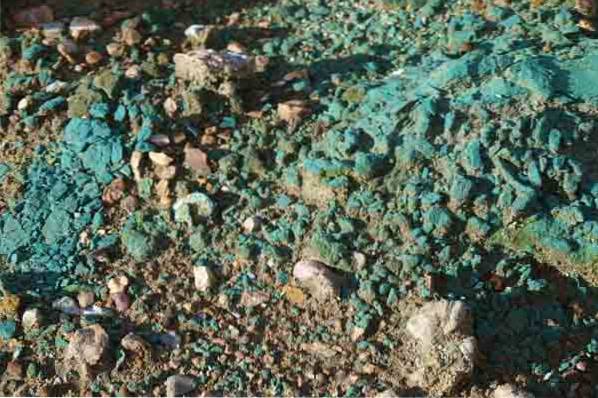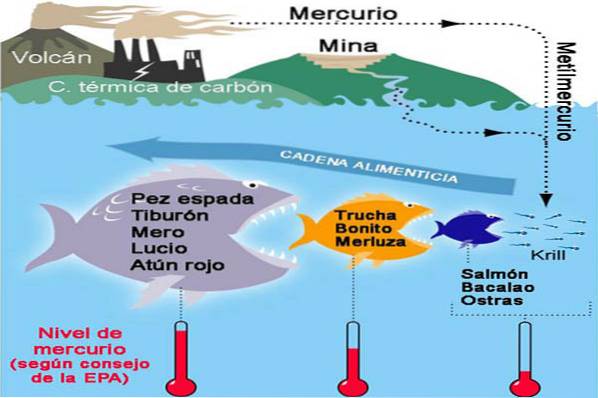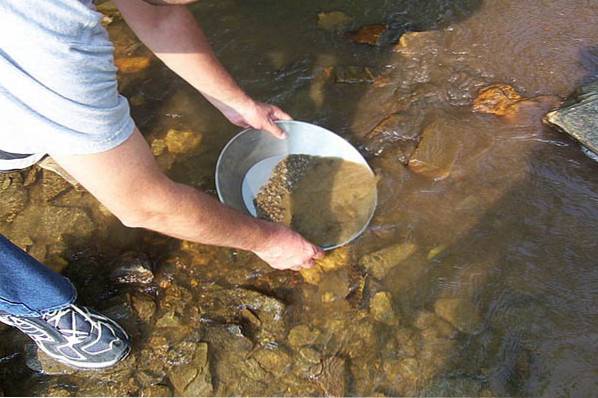
What are the health or environmental implications of heavy metals?

The Health and environmental implications of heavy metals they are quite serious, since they are toxic substances at low concentrations. It consists of more than 50 chemical elements with an atomic weight greater than 20 and a density greater than 4.5 g / cm3..
Some heavy metals are essential in the human diet such as iron, cobalt, copper, iron, manganese, molybdenum, vanadium, strontium and zinc. However, other cases such as lead, cadmium, mercury and arsenic are extremely toxic to both humans and other organisms..

Heavy metals are found in nature, but human activities promote their artificial diffusion and concentration. Especially for its use in paints and dyes, as well as catalysts in different processes, for example in the paper and plastic industry.
In some cases it is contamination by natural sources, as in some cases with arsenic and cadmium. In any case, heavy metal pollution represents a serious problem for society and for natural ecosystems..
The maximum concentrations of heavy metals accepted in water and food for human consumption are defined by the World Health Organization (WHO). The current reality is that in many regions of the world the concentrations detected exceed these limits
Article index
- 1 Health implications
- 1.1 Minamata disease (Japan)
- 1.2 Lead poisoning or plumbosis
- 1.3 Cadmium contamination
- 1.4 Contamination by arsenic or arsenicosis
- 1.5 Copper contamination
- 2 Implications for ecosystems
- 2.1 Bioaccumulation
- 2.2 Damage to plants
- 2.3 Conditions to animals
- 2.4 Pollution of bodies of water
- 3 Implications for society
- 3.1 Morbidity and mortality
- 3.2 Food security
- 3.3 Loss of drinking water
- 3.4 Economic losses
- 4 References
Health implications
Each contaminating heavy metal has its own mechanism of action and accumulates in specific tissues or organs..
Minamata disease (Japan)
In the 1950s, a childhood neurological syndrome was detected in the coastal population of Minamata in Japan. It was determined that the cause was the ingestion of fish contaminated with mercury from an industry that used mercury chloride..
The mercury affected the unborn mothers and the newborns developed serious neurological problems. By 2009, 2,271 victims and more than 10,000 cases had been identified.
Lead poisoning or plumbosis
This disease is caused by ingesting lead, either from contaminated water, air, or food. Lead is neurotoxic, that is, it affects the nervous system, causing neuronal damage, especially in the brain..
It also affects the bone marrow and also accumulates in the kidneys causing kidney failure. Lead in the blood causes anemia by blocking the synthesis of hemoglobin.
Cadmium contamination
The ingestion of cadmium causes the disease known as Itai-Itai or osteoarthritis, which mainly affects bone tissue. This disease causes osteoporosis with multiple fractures, anemia, kidney and lung damage.
Cadmium can enter both the oral and respiratory routes, reaching the circulatory system and accumulating in the kidneys and liver. Cigarettes are a source of cadmium due to contamination of the soils where tobacco is grown.
Arsenic or arsenicosis contamination
The world population at risk of exposure to arsenic exceeds 150 million people. Arsenicosis causes respiratory problems, cardiovascular and gastrointestinal diseases and has been indicated as a cause of lung, bladder and skin cancer, among others.
Copper contamination
Contamination by this metal causes damage to the liver, kidneys, anemia, irritations of the small and large intestines. High levels of copper sulfate contamination generate necrosis of the liver, causing death.
Food stored in copper containers can also be contaminated with this metal..
Implications for ecosystems
Heavy metal pollution is one of the most serious causes of degradation of aquatic and terrestrial environments. Heavy metals affect both plants and animals.
Bioaccumulation
Metals are persistent and therefore cannot be degraded or destroyed. Thus, they accumulate in the tissues and are ingested from one link to another in the food chains.

For example, some species of bivalves, shellfish, and mollusks absorb cadmium and mercury from water and accumulate it in their bodies. These organisms are then consumed by predators of the next trophic level, including humans. In the case of cadmium, a predator that consumes one kilo can concentrate from 100 to 1000 µg.
Example from Minamata (Japan)
In Minamata Bay, the mercury dumped by the Chisso petrochemical company between 1932 and 1968 was consumed and processed by bacteria. These bacteria were either consumed by plankton or excreted fat-soluble mercury and from there it passed to the rest of the trophic chain..

In this process, it accumulated in the adipose tissues of the fish in increasing concentrations. The last link in that food chain was the human being, with the dire consequences that it produced.
Damage to plants
Cadmium, for example, is recognized as one of the heavy metals with the greatest tendency to accumulate in plants. This metal causes severe imbalances in the nutrition and water transport processes in plants..
Plants contaminated with cadmium show alterations in stomatal opening, photosynthesis and transpiration.
Animal conditions
The heavy metals once they pollute the ecosystem cause serious affections to the wild life. For example, mercury contamination in animals causes severe mouth, intestinal, and kidney problems..
The circulatory system is also affected, causing heart rhythm disturbances. It also reduces reproductive efficiency by affecting fertility, malformations in fetuses and causing abortions..
Pollution of bodies of water
Both marine and freshwater aquatic ecosystems are among the most affected due to the high mobility of heavy metals in this environment. One of the most serious problems of contamination of bodies of water with heavy metals is the case of mercury.
Mining sludge cases
In Omai (Guyana, 1995) there was a break in the dike of a dam containing mining sludge in a gold mine. In these mines, cyanide is used to separate the metals from the bedrock and the waste reached the Potaro River, causing the death of fish, birds and other animals..

A similar case occurred in Aznalcóllar (Spain, 1998) with the break of the dike in a pyrite mine. On this occasion, the waste carried by the water or directly discharged contaminated the Guadalquivir river basin..
This produced the contamination of the Doñana biosphere reserve in the Guadalquivir estuary. Among the polluting heavy metals were arsenic, lead, cadmium, copper, iron, manganese, antimony and mercury.
Implications for society
Morbidity and mortality
Diseases caused by heavy metal contamination cause morbidity and mortality. Diseases such as Minamata or lead poisoning cause serious learning delays due to the neurological problems they cause.
Food safety
Recent studies indicate the presence of heavy metals and metalloids in vegetables such as lettuce, cabbage, squash, broccoli and potatoes. Among the polluting heavy metals are mercury (Hg), arsenic (As), lead (Pb), cadmium (Cd), zinc (Zn), nickel (Ni) and chromium (Cr).
The fundamental medium for this contamination is contaminated irrigation water. Heavy metals have also been found in different concentrations in fish, meat and milk as a result of bioaccumulation.
Drinking water losses
Drinking water is one of the strategic resources today, because it is becoming increasingly scarce. Heavy metal contamination in rivers and underground aquifers reduces the available drinking water sources.
Economic losses
Both the decontamination of waters and soils affected by heavy metals, as well as the expenses generated by health problems, represent large economic expenditures.
On the other hand, heavy metal contamination can negate important sources of income. An example of this is the restrictions on the export of cocoa from certain areas of Venezuela due to contamination with cadmium in the soil..
Japan case and the Itai-Itai disease
In Japan, due to the contamination of agricultural land by cadmium from mining, the cultivation of rice on these lands was prohibited. This caused serious economic losses to farmers..
In 1992, the expenses generated by cadmium contamination totaled 743 million dollars for health expenses. Compensation for damage to agriculture reached 1.75 billion dollars and 620 million dollars per year were invested in the decontamination of the Jinzú River..
References
- Bejarano-González F (2015). Global chemical pollution. Ecologist Nº 38: 34-36.
- ELIKA (2017). Types of food contamination. Basque Foundation for Food Safety. 5 p. (Viewed August 26, 2019). https://alimentos.elika.eus/wp-content/uploads/sites/2/2017/10/6.Tipos-de-contaminaci%C3%B3n-alimentaria.pdf
- Londoño-Franco, L.F., Londoño-Muñoz, P.T. and Muñoz-García, F.G. (2016). The risks of heavy metals in human and animal health. Biotechnology in the Agricultural and Agroindustrial Sector.
- López-Sardi E. Chemistry and the environment. University of Palermo. Argentina. (Viewed on August 26, 2019) https://www.palermo.edu/ingenieria/downloads/CyT5/CYT507.pdf
- Martorell, J.J.V. (2010). Bioavailability of heavy metals in two aquatic ecosystems of the Andalusian South Atlantic coast affected by diffuse pollution. Faculty of Sciences, University of Cádiz.
- Reyes, Y.C., Vergara, I., Torres, O.E., Díaz-Lagos, M. and González, E.E. (2016). Heavy Metal Contamination: Implications for Health, Environment and Food Safety. Engineering Research and Development Magazine.
- Reza R and G Singh (2010). Heavy metal contamination and its indexing approach for river water. International Journal of Environmental Science & Technology, 7 (4), 785-792.
- Rodríquez-Serrano, M., Martínez-de la Casa, N., Romero-Puertas, M.C., Del Río, L.A. and Sandalio, L.M. (2008). Cadmium Toxicity in Plants. Ecosystems.
- Travis CC and Hester ST (1991). Global chemical pollution. Environmental Science & Technology, 25 (5), 814-819.



Yet No Comments